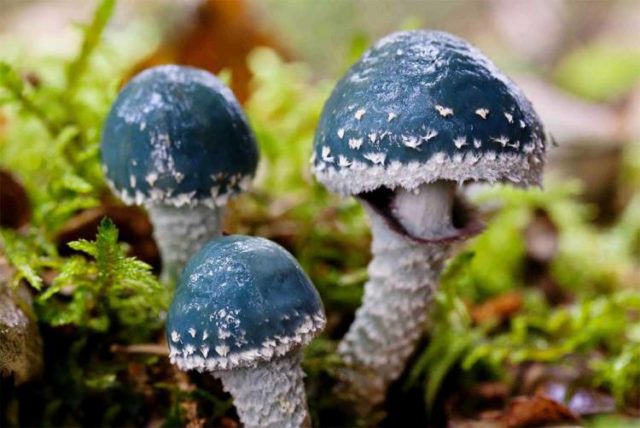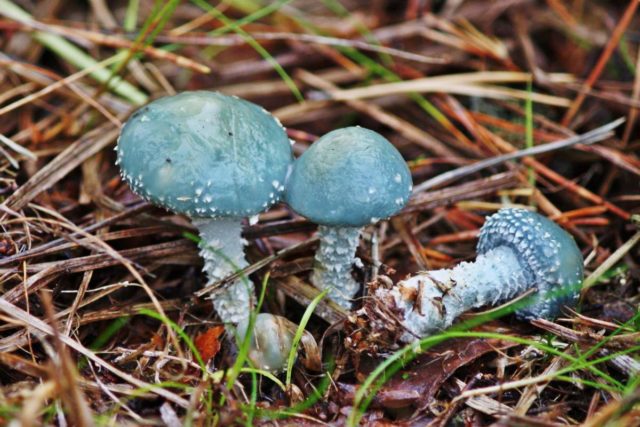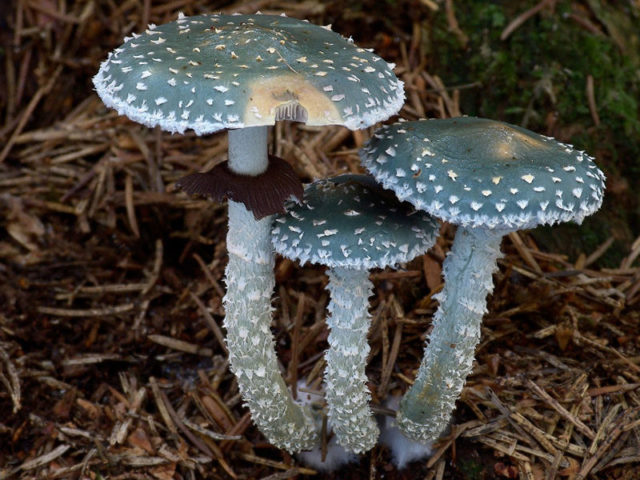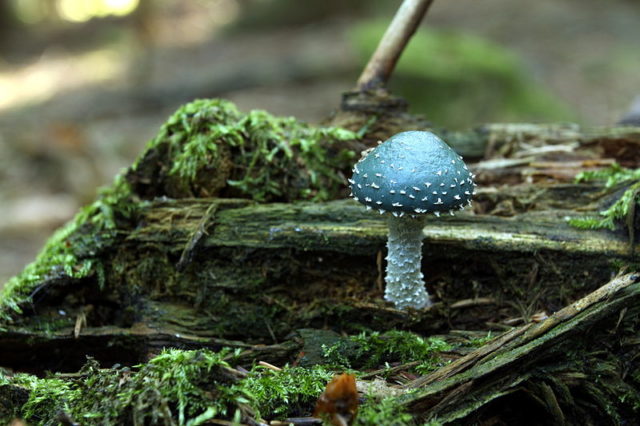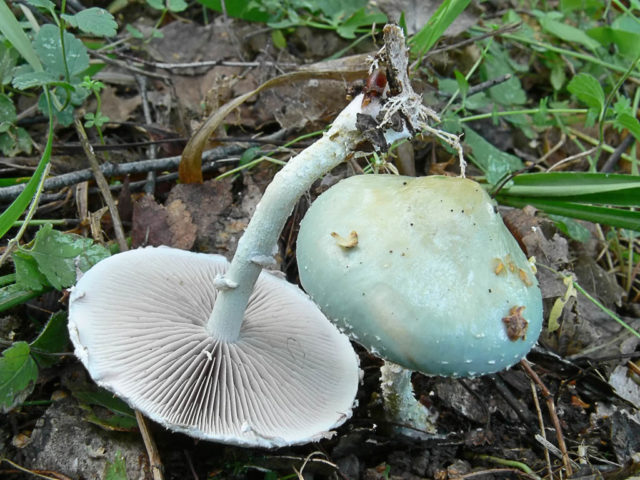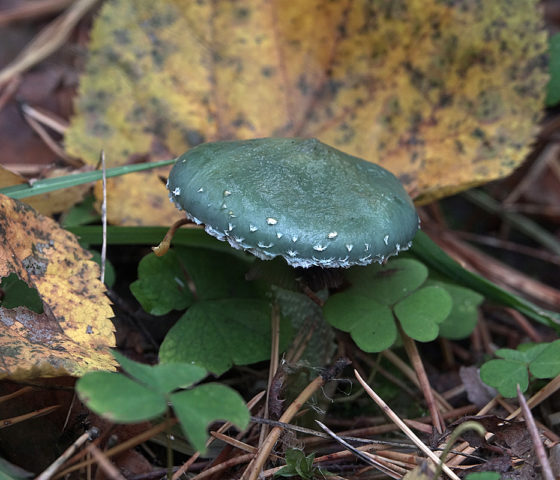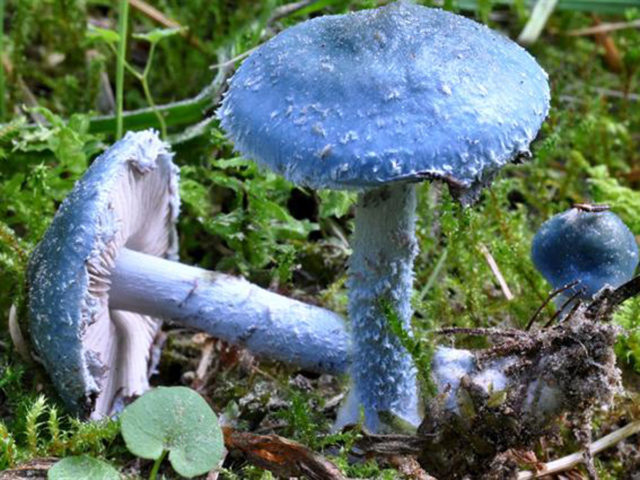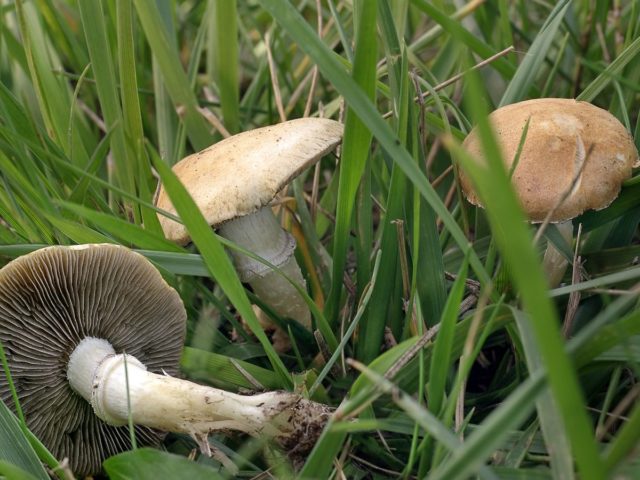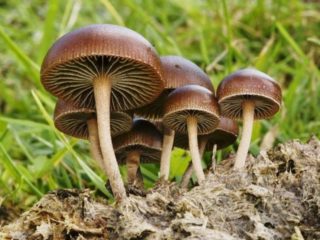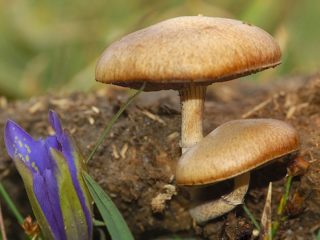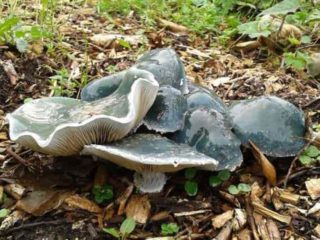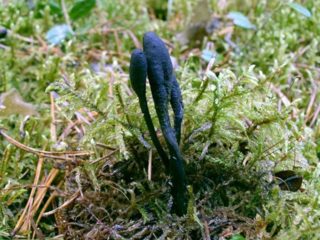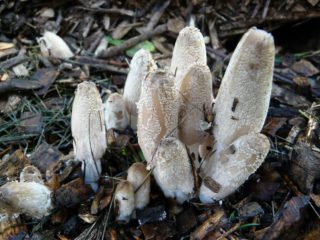Content
Blue-green stropharia is an interesting mushroom with mild poisonous properties, which, nevertheless, is allowed to be eaten.For stropharia to be safe, it is important to be able to distinguish it from similar species and prepare it correctly.
Description of blue-green stropharia
Photos and descriptions of blue-green stropharia make it easy to recognize it in the forest. The mushroom, which is also called copperhead treshling yar, has characteristic external features and bright color.
Description of the cap
The cap of the troischling is broad-shaped, reaching from 3 to 12 cm in diameter. The photo of the blue-green stropharia mushroom shows that in young fruiting bodies the shade of the cap is closer to bluish-green, and the skin is covered with a slimy film. As the cap ages, it dries out and yellow and brownish spots appear on it.
Young mushrooms can be recognized by a clear tubercle in the center of the cap and by the remains of a blanket at the edges. The plates on the cap are gray-green in color, with age they acquire a dark brown or even purple tint, and the edges of the hymenophore remain white.
Description of the leg
The leg of the blue-green stropharia reaches 12 cm in height and 2 cm in girth. The structure is slippery, scaly or shaggy, sometimes with a preserved ring. The color of the leg is pale greenish or pale bluish, almost the same shade as the cap.
Where and how does it grow
You can usually find blue-green stropharia on the wood of dead trees, on stumps and fallen trunks, on spruce, pine and fir wood, less often it grows on deciduous trees. The fungus is widespread in all areas with a temperate climate, appearing mainly closer to autumn - from late August to mid-October.You can meet it in the Moscow region and in Siberia, in the Far East and in the southern regions.
Typically, treshling verdigris grows in groups or dense bunches; single fruiting bodies can rarely be seen.
Is blue-green stropharia edible or not?
Different sources have their own opinions regarding the edibility of this variety. The pulp contains a dangerous acid with a narcotic effect, which is part of opium. However, in general, the mushroom is considered edible, although slightly poisonous, with hallucinogenic properties.
You cannot eat verdigris troschling in its raw form, it will be harmful to your health. However, after boiling, the main part of the dangerous substances leaves the pulp, and stropharia becomes suitable for food use.
How to cook blue-green stropharia
The mildly poisonous and hallucinogenic mushroom stropharia blue-green needs especially careful processing before consumption. If you neglect preparation, then not only food poisoning will occur, but also serious mental consequences. Eating a large amount of treshling can have the same effect on the body as a powerful drug with a hallucinogenic effect.
Preparing mushrooms
When processing blue-green fruiting bodies, it is important to remove the thin skin from the caps, as this is where the concentration of harmful substances is highest. The skin peels off easily, much the same as that of butterfish.
The peeled fruiting bodies must be placed in a deep pan with salted water and boiled for at least 15 minutes. After this, the caps are thrown into a colander, and the broth is drained - it is unsuitable for use as food.
How to pickle blue-green stropharia
A properly peeled and boiled mushroom is suitable for further pickling.The recipe for marinating treshling is as follows:
- pour water and 100 ml of table vinegar into a deep saucepan;
- add 1 large spoon of salt and bring the water to a boil;
- 1 kg of prepared stropharia is placed in the solution.
When the fruiting bodies release juice and foam appears on the surface of the water, it will need to be removed. Boil the stropharia in water and vinegar for 15 minutes, then add 1 small spoon of sugar, a few peas of allspice, a little cloves and cinnamon to the marinade. You can also add bay leaf or star anise to taste.
The marinade is boiled for another 10 minutes, and then removed from the stove and poured hot into sterilized jars. After the pieces have cooled under a warm blanket, they can be put in the refrigerator for further storage.
Salting blue-green stropharia
The description of the use of blue-green stropharia offers another recipe - cold pickling of troischling.
To prepare you will need:
- cut large caps of boiled mushrooms into small pieces, and leave small ones whole;
- place stropharia in a jar in layers of 6-10 cm, alternating each layer with a large amount of salt;
- along with salt, add garlic and other aromatic spices to taste;
- alternate salt and mushrooms until the jar is filled to the top.
After this, the neck of the container is covered with thick gauze and a heavy load is placed on top. In just a couple of days, the stropharia in the jar will release juice abundantly, and in total it will take 30-40 days to pickle. During this time, the gauze on the neck of the jar will need to be changed regularly to prevent mold from appearing on it.
Restrictions and contraindications
Since blue-green stropharia Stropharia Aeruginosa has a hallucinogenic effect on the body, it should be consumed in very small quantities even after careful processing. In case of an overdose of treshlings, nervous overexcitation is observed, hallucinations occur - visions that can last several hours. In general, the effect of blue-green stropharia on the body in case of overdose is similar to the effect of the drug LSD and leads to paranoia, delirium, anxiety and euphoria.
It is forbidden to consume treshling on an empty stomach or in a weakened state, in which case the toxins will have a stronger effect. The mushroom is absolutely contraindicated for people suffering from mental disorders; it is strictly forbidden to be consumed by pregnant women, young children and adolescents under adulthood.
Also, blue-green stropharia has contraindications quite typical for mushrooms. It is better not to eat it if you have sluggish digestion and a tendency to constipation, since mushroom pulp is difficult to digest. It is better to refuse the product in case of exacerbation of chronic gastric diseases.
Doubles and their differences
Despite the recognizable appearance and photo of the blue-green stropharia, it can be confused with some other mushrooms. Trischling's doubles are mostly conditionally edible, suitable for food use after processing.
Sky blue stropharia
Mushrooms belong to the same genus and are therefore similar to each other. But the sky blue stropharia has a more saturated blue hue with small ocher spots.In addition, the cap of the blue variety is usually flattened in adulthood, while the blue-green variety often retains a conical shape.
Unlike troeschling, blue stropharia does not grow on dead tree wood, but in parks and pastures, on roadsides and other places with fertile soil. The mushroom is considered edible, but due to its unusual appearance it is rarely used in cooking.
Crown stropharia
This variety is very similar to the blue-green one in size and shape; the cap of the crowned type is also conical, with scraps of the bedspread along the edges. But you can distinguish the species by color - crowned stropharia has a yellowish, ocher, beige or lemon tint.
It is not customary to eat the mushroom; it has been little studied, and various sources classify it as conditionally edible or clearly poisonous.
Interesting facts about blue-green stropharia
The unusual verdigris verdigris troischling looks very beautiful, but due to its shape and color it is perceived with caution by mushroom pickers. Although the harmful properties of treshling are reduced when properly processed, most people avoid using it as food.
Other interesting facts are associated with blue-green stropharia:
- Even in ancient times, treshling and similar species were used for religious rituals - the hallucinogenic properties helped priests and shamans enter a state of special ecstasy.
- Currently, information about the edibility of stropharia differs in different countries. In Europe it is simply considered tasteless, but in America it is classified as poisonous.
It is curious that on the slimy cap of the troischling you can often see a large number of dead insects in a semi-decomposed state.There is a version that the mucus on the cap helps digest the bodies of flies and mosquitoes, but this has not yet been proven for sure.
Conclusion
Stropharia blue-green is a permitted, but potentially dangerous, mushroom. Before using it for food, it must be thoroughly processed to neutralize possible harm.
